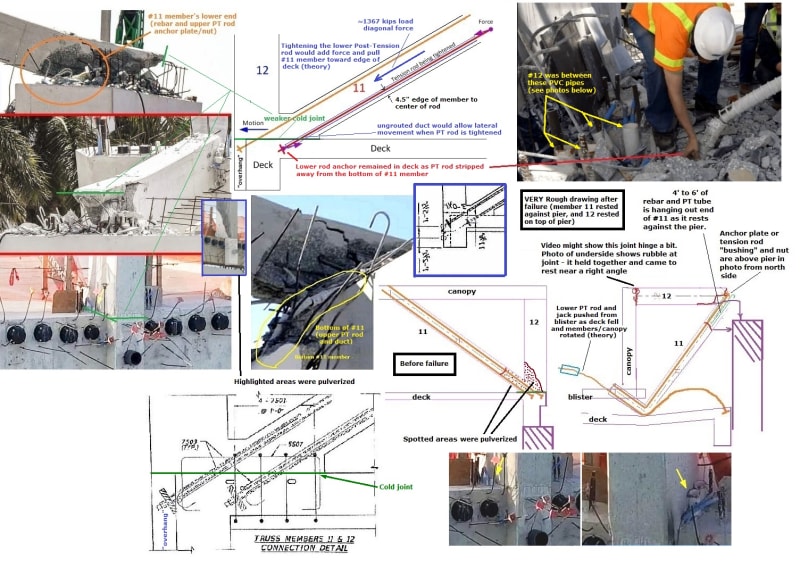My posts were meant to summarize everything here after getting new specs showing PT anchors and reinforcement in deck, and to add the 3D stress analysis. I got sidetracked with the blisters... I'd been through all posts a couple times, but went back to beginning as 3DDave suggested and found where Rubio, on the first day (and had inside info), said the rods were being tightened when the span collapsed.. there still seemed some question about this.
------------------------------------------------------------------------------------------------
The Mad Spaniard said:
the node concrete side faces are compromised by the vertical PT holes and the drainage pipe hole.
This has been discussed a bit, along with a suspected cold joint at the deck/member junction - which was confirmed in the latest spec.
A "summary collage" (high res attached) shows the bottom of post-collapse #12 on top of pier.
It's fairly flat with rebar hanging out, and appears to have sheared at the cold joint.
The small insert shows intact highlighted area that was pulverized (Meerkat, IV 23 Mar 18 13:43).
Bottom right shows large PVC pipes on sides of #12 intact (gwideman, IV 23 Mar 18 10:54).
Top right shows post-collapse with pipes still in deck. I'd assume #11 and #12 moved straight back - noted in video loop and frame grab sequence mentioned above (30 Apr 18 23:18).
A larger PVC pipe was below the cold joint, and #11 diagonal PT rod ducts crossed through it as larger ovals.
Spec shows no PT rods in vertical #12.
The upper PT rod anchor plate was within the "overhang", and has little concrete behind or to sides of it. Plate spec for 1.75" PT rod is 8"x12", but it doesn't look that big (exposed on top of pier).
This area was weak.
Lastly, the top center photo is from gwideman, IV 23 Mar 18 17:09. I suspect the #11,12,deck joint was stressed during the move and the cold joint/edge of the deck was affected. The upper rod had been tightened, and the lower rod was being tightened which would add to the dead load force pushing #11/12 north (total ~1927 kips/Peter's calcs; ~1400 kips horizontal with 30 degree member).
As Toomas noted, the edge and bottom of #12 were highly stressed, with only part of 12 attached to the deck. It's possible the workers were told to "give it a little more" on #11's PT rods because of the cracks - the rods were spec'ed at 280 kips, with typical (Williams) Min Ultimate Strength at 390. There appears to be some spalling (epoxybot, V, 29 Mar18 05:33) where the "overhang" sheared, as the deck fell.


